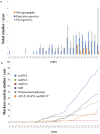Evolutionary Genetics of Cacti: Research Biases, Advances and Prospects
- PMID: 35328006
- PMCID: PMC8952820
- DOI: 10.3390/genes13030452
Evolutionary Genetics of Cacti: Research Biases, Advances and Prospects
Abstract
Here, we present a review of the studies of evolutionary genetics (phylogenetics, population genetics, and phylogeography) using genetic data as well as genome scale assemblies in Cactaceae (Caryophyllales, Angiosperms), a major lineage of succulent plants with astonishing diversity on the American continent. To this end, we performed a literature survey (1992-2021) to obtain detailed information regarding key aspects of studies investigating cactus evolution. Specifically, we summarize the advances in the following aspects: molecular markers, species delimitation, phylogenetics, hybridization, biogeography, and genome assemblies. In brief, we observed substantial growth in the studies conducted with molecular markers in the past two decades. However, we found biases in taxonomic/geographic sampling and the use of traditional markers and statistical approaches. We discuss some methodological and social challenges for engaging the cactus community in genomic research. We also stressed the importance of integrative approaches, coalescent methods, and international collaboration to advance the understanding of cactus evolution.
Keywords: Cactaceae; evolutionary genetics; genomics; literature survey.
Conflict of interest statement
The authors declare no conflict of interest.
Figures




References
-
- Silva G.A.R., Antonelli A., Lendel A., Moraes E.D.M., Manfrin M.H. The impact of early Quaternary climate change on the diversification and population dynamics of a South American cactus species. J. Biogeogr. 2017;45:76–88. doi: 10.1111/jbi.13107. - DOI
-
- Hunt D.R., Taylor N.P., Charles G. New Cactus Lexicon. DH Books; New York, NY, USA: 2006. 900p
-
- Korotkova N., Aquino D., Arias S., Eggl U., Franck A., Gómez-Hinostrosa C., Guerrero P.C., Hernández H.M., Kohlbecker A., Köhler M., et al. Cactaceae at Caryo-phyllales. org–a dynamic online species-level taxonomic backbone for the family. Willdenowia. 2021;51:251–270. doi: 10.3372/wi.51.51208. - DOI
Publication types
MeSH terms
LinkOut - more resources
Full Text Sources
Miscellaneous

